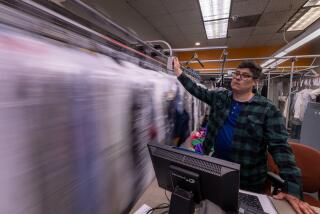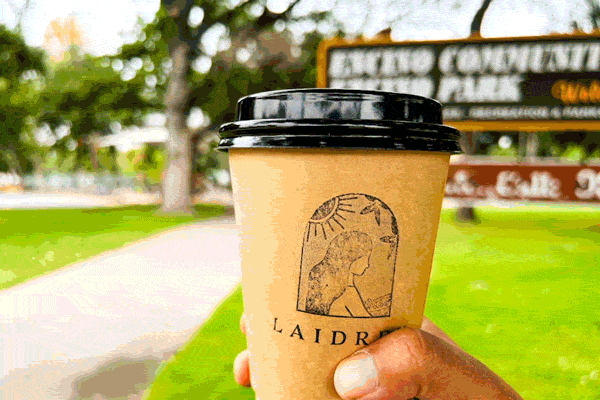A community in flux: Will Boyle Heights be ruined by one coffee shop?

Activists have declared war against a growing number of Boyle Heights art galleries. (July 18, 2017)
As dusk settled over a mostly industrial landscape of warehouses covered with graffiti murals, Fernando Ramirez stood in front of the lone art gallery late Saturday afternoon and urged fashionably dressed visitors not to go inside.
“Don’t contribute to the displacement of the people in the community right here in Boyle Heights. Our rents are going up because of the art galleries,” he said. “Please do not cross the picket line!”
Ramirez, 38, had come to this desolate stretch of Boyle Heights with other protesters to once again declare war against a growing number of neighborhood art galleries and what he and other activists fear they foreshadow: a wave of gentrification.
On Sunday, a few miles east, a smaller group of protesters gathered outside a white storefront on Cesar Chavez Avenue with the word “COFFEE” painted in black.
Months after the activists won an apparent victory by pressuring an art gallery to close down amid what the owners called “constant attacks,” the protests against the galleries — and now Weird Wave Coffee — have illustrated both the demonstrators’ knack for annoying their targets as well as the limits of their tactics.
Along the gray desolation of Anderson Street, they have contended with sometimes well-financed galleries that can largely weather the disruptions. And on the busy stretch of Boyle Heights that houses Weird Wave Coffee, they have confronted residents who don’t take kindly to being told what to do or buy.
Anti-gentrification forces spent weeks trolling the coffee house on Instagram before and after it opened June 15. They held protest rallies outside the business, holding posters, including one that read “… White Coffee” and included an expletive, and another that said “AmeriKKKano to go.” They passed out fliers with a parody logo that read “White Wave.”
Some Latino residents who defended Weird Wave Coffee said they were called “coconuts” by activists. Brown on the outside, white on the inside.
“It makes us look bad,” Koda Torres said of the confrontational tactics used against the cafe. “The way they handle the situation of gentrification wasn’t appropriate. They were almost vandalizing their windows, harassing the customers, calling people sellouts and racists.”
But for the protesters, the stakes are too high for niceties. As they see it, if Boyle Heights is taken over by the forces of gentrification, then no other neighborhood is safe.
“It’s a threat to local businesses and it’s one more sign of gentrification that we need to defeat,” Leonardo Vilchis, director of Union de Vecinos, said of Weird Wave Coffee. “Otherwise this neighborhood is going to end up just like Highland Park.”
Early on in the battle against the galleries, protesters stormed into shows and threw detergent on patrons as well as the food they were being served, according to witnesses and news reports. The Los Angeles Police Department investigated the graffiti of one gallery that included an expletive and said “… White Art.”
The Eastside has long been a center of Los Angeles’ protest movements, whether it was residents marching against the Vietnam War in the 1970s or more recently demonstrating for immigrant rights.
But the activists who have fought against gentrification have so far failed to rally a large number of residents to their cause.
Some longtime residents like the rising property values and increased retail choices. Others are concerned about people being pushed out of the neighborhood. They also struggle to connect the dots, like the activists, between widespread gentrification and a cafe or art galleries in an isolated part of Boyle Heights.
I don’t know the word ‘gentrification.’ I know the word ‘displacement.’
— Nancy Garcia, Boyle Heights resident
“I don’t know the word ‘gentrification,’” said Nancy Garcia, 31, a Boyle Heights resident. “I know the word ‘displacement.’”
About 100 people, including Garcia, showed up at a separate rally activists organized last month at Mariachi Plaza to support mariachis and other tenants facing eviction from homes that will be converted into luxury apartments. The atmosphere was spirited but peaceful, with musicians playing in the background.
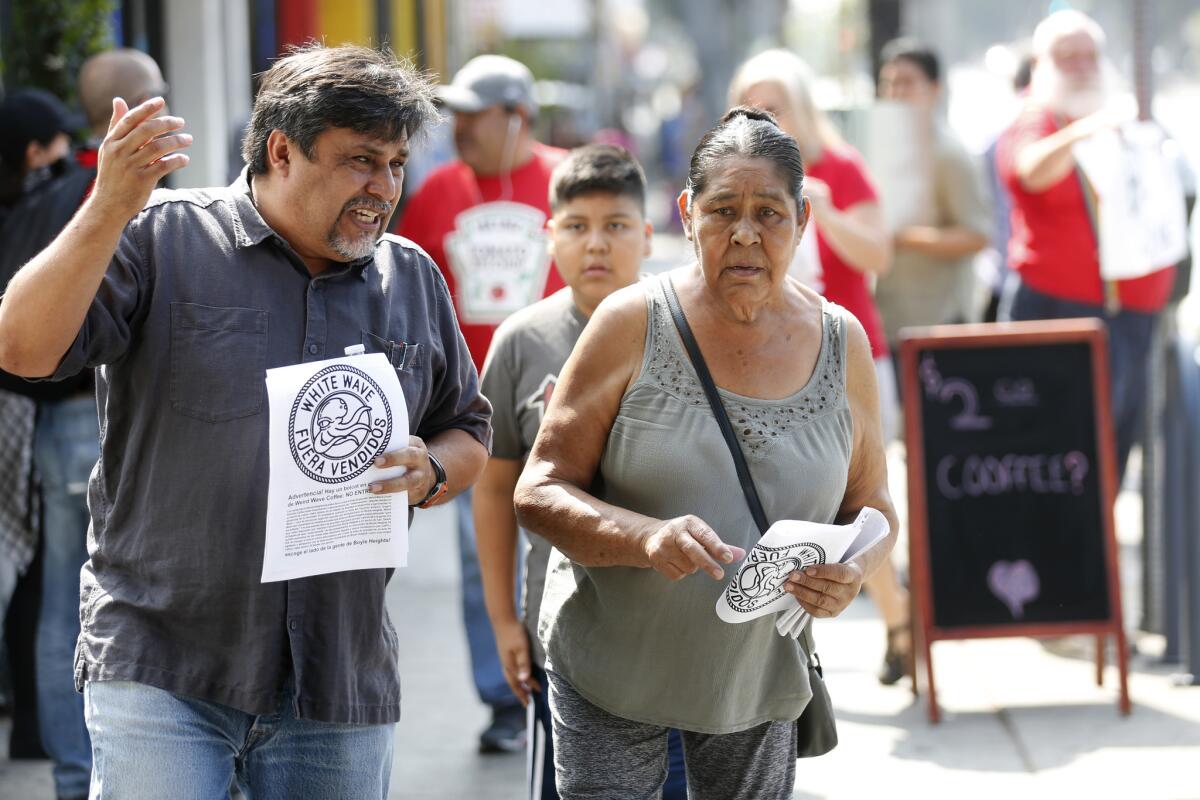
When the owners of Weird Wave Coffee decided to open their shop in Boyle Heights, they were aware of the movement against gentrification. But they did not think they would be targeted like the art galleries. They were selling coffee, not pricey paintings.
Also, Weird Wave was hardly the first cafe or trendy business in Boyle Heights.
The arrival of the Metro Gold Line nearly eight years ago paved the way for change, along with rising property values and the boom of downtown L.A.
Not far from 1st Street and Boyle Avenue, Eastside Luv, a popular wine bar, opened years ago. Across Mariachi Plaza, a Victorian-era building, once home to many mariachis, went through extensive restoration and served as affordable housing. In 2014, La Monarca Bakery, an upscale Mexican cafe and panaderia, opened in the building’s ground floor.
“I thought maybe we’re OK now,” said Mario Chavarria, co-owner of Weird Wave Coffee. “It was a year ago, and you know people’s perceptions change. But when they started posting notes on the window, I thought, well, maybe not quite.”
Initially, protesters thought they were protesting against two owners, Jackson Defa and John Schwarz, who are white.
Defa, 34, a San Francisco native, said he tried to extend an olive branch to the protesters when they showed up at the business, but was rejected. Defa may have made things more difficult when he snapped an Instagram photo of a fruit vendor and used the hashtag “local yokel,” a phrase used to describe someone living in a rural area. Defa removed the post, apologized for the remark and said he was actually making fun of himself, not the vendor, whom they sometimes purchase fruit from.
But protesters point to the incident as an example of how outsiders actually feel about the community.
Defa said he understands the protesters’ concerns and probably would have supported them. He said that in San Francisco, he saw his rent jump from $700 to $2,000 in a year because of gentrification and moved to L.A. for a new start. He worked at a coffee shop in West L.A. until the owner sold it.
Schwarz, 33, a video game developer, lost his job last June. He held a few jobs to make a living and rents a room for $700 in the West Adams area.
“I wasn’t surprised,” Defa said of the protesters. “I was surprised they didn’t want to listen.”
Chavarria, who came to the U.S. from El Salvador when he was 10, put up $100,000 of his own money to open the business. When the activists began protesting, after Defa couldn’t get the group to listen, Chavarria was called in to speak to the protesters, hoping they would see that the business was not just owned by two white guys. A resident even placed a sign in the shop’s window pointing out that it was a Latino-owned business.
“So I went out there and said, ‘What’s going on? What seems to be the problem?’ And they said, ‘These guys in there are trying to change the community,’” Chavarria recalled. “And I said, well, I don’t think we’re doing that. I’m part of the business. This is my place and I think, as a Hispanic, you’re willing to support someone like you who is trying to get ahead, using his own private money.’”
Chavarria said he was called a vendido — sellout.
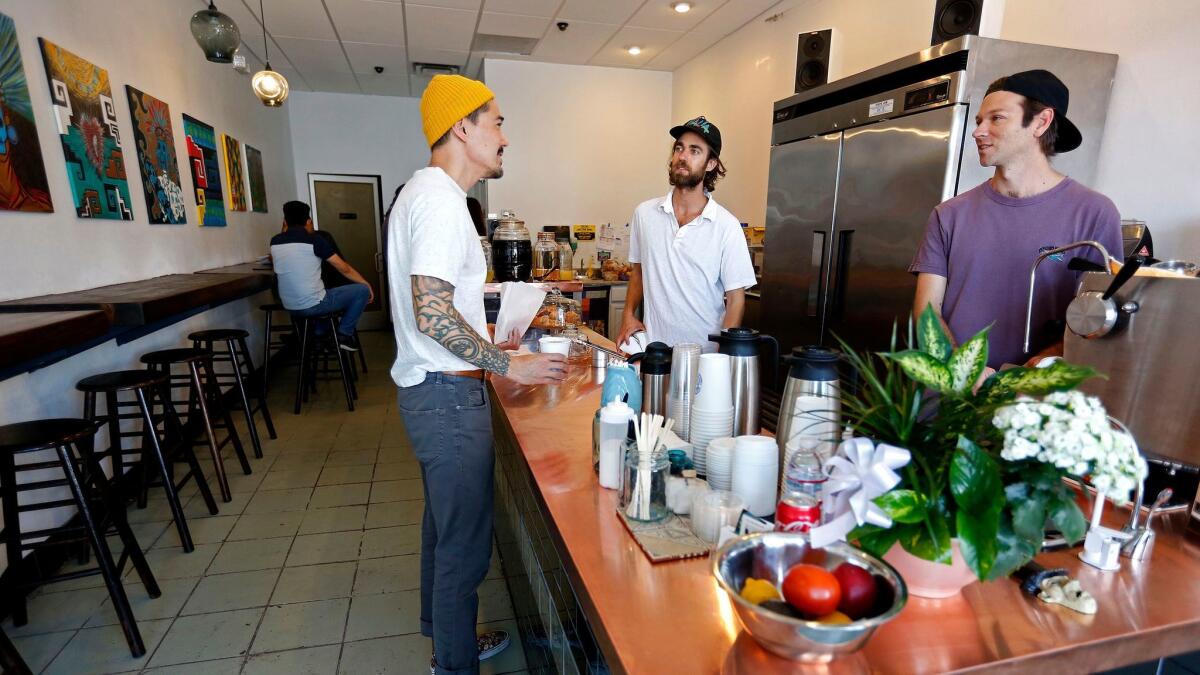
Critics like Vilchis say the shop’s minimalist aesthetics and hipster style represent a danger to the community, encouraging property owners to increase rents and eventually price out longtime tenants.
But though Vilchis and other activists oppose some businesses, they also admit they can be selective in their opposition.
They don’t protest a Starbucks in Boyle Heights, for instance, because it’s a “post-gentrification” business that no longer poses a threat, Vilchis said.
He said his problem isn’t with the products that businesses like the galleries or Weird Wave Coffee sell.
“It doesn’t matter how good of a cup of coffee it is, it doesn’t matter the good intentions the owners of the business have,” he said. “It’s about the effect that the coffee shop has on the local neighborhood. It’s not about taste, it’s about effect.”
A day after Weird Wave Coffee opened in mid-June, the protesters’ confrontational tactics got the attention of the media, but the coverage only made others in the area curious about the cafe. Some residents and business owners also found themselves targets.
“I really couldn’t believe people are that mean in our neighborhood,” said Francisco Torres, 47, a longtime resident. “I didn’t like that.”
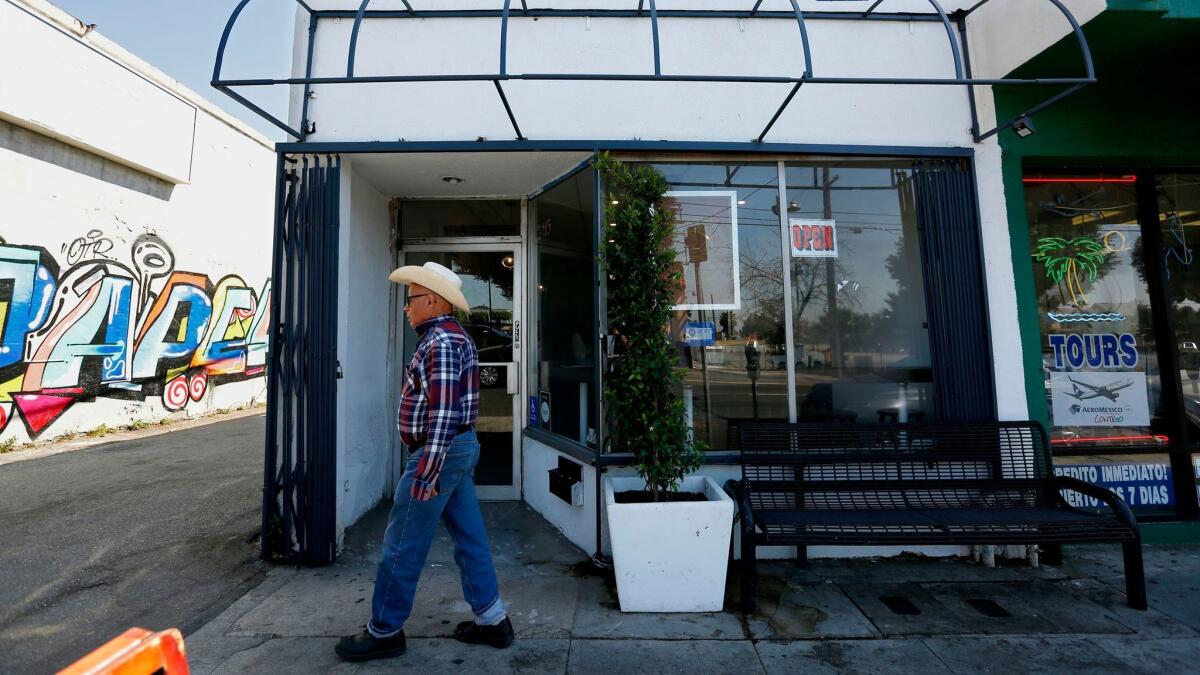
Protesters gathered outside the shop, live-streaming the event and recording themselves as they paced back and forth, holding signs. But they also recorded telling interactions between residents and protesters.
In one recording, Ashley Aragonez, 29, expresses annoyance with the anti-gentrification activists.
“What are you gonna get out of this? Do you think they’re going to close down?” she told a protester.
“That’s our mission — for them to get out of the neighborhood,” he said.
Another protester, a woman, chimed in: “What do you want? Do you want a white coffee shop here?”
“I want to be able to come and drink coffee and not have people yelling at me,” Aragonez said.
“That’s not gonna happen,” the young man replied.
On Saturday night, visitors to two galleries targeted by activists largely went about their business. Some walked around, looking at art and holding cans of beer, at times getting into debates with protesters.
Lorraine Molina, 46, of Eagle Rock told a protester she owned a gallery downtown before rising rents forced her out.
“I think they’re naive and I think they’re militant and they’re so ill-informed, they only understand what they’re interested in,” she said. “That’s the problem. The dialogue isn’t big enough, it isn’t expansive enough and inclusive enough.”
For more Southern California news, follow @latvives on Twitter.
Times staff writer Steve Saldivar contributed to this report.
ALSO
For five years, she asked ‘Who murdered my daughter?’ Along the way, she found paths to peace
Surge in Latino homeless population ‘a whole new phenomenon’ for Los Angeles
More to Read
Sign up for Essential California
The most important California stories and recommendations in your inbox every morning.
You may occasionally receive promotional content from the Los Angeles Times.

